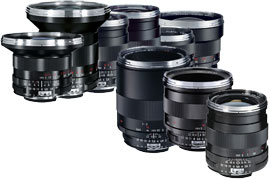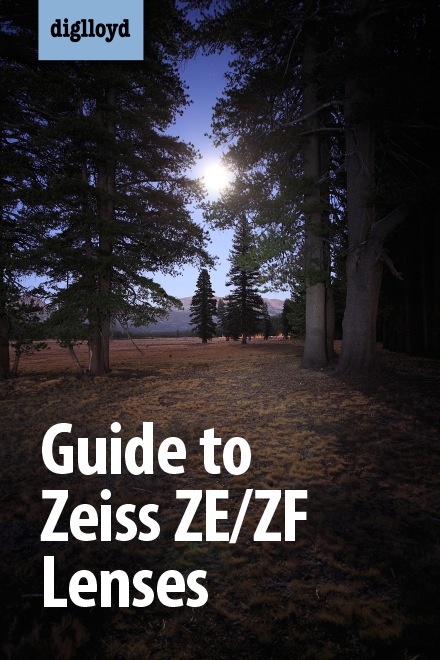
|

$220 SAVE $130 = 37.0% Western Digital 16.0TB Western Digital Ultrastar DC HC550 3.5-in… in Storage: Hard Drives
|

|

|

|

|
Focusing, Build Quality, Color, Flare, Bokeh
Related: bokeh, Canon, Canon DSLR, focusing, lens flare, Nikon, Nikon DSLR, Zeiss, Zeiss DSLR lenses, Zeiss lenses

Why buy a manual focus lens today?
While autofocus is required for some shooting situations, manual focus with the buttery-smooth focusing helicoid of the ZF.2 or ZE lines is well suited to numerous photographic opportunities, not to mention situations where the autofocus sensors just don't cover the desired area
With Live View magnification as found on current Nikon and Canon DSLRs, precision manual focus works so much better with a focusing helicoid, as compared with the twitchy autofocus-in-manual-mode AF lenses. As a worst-case example, I literally cannot even remove my finger from the Nikon 50/1.4D focusing barrel without disturbing the focus! Precision work does not tolerate even minor focus errors with high resolution digital cameras--there is no “post” for focus errors.
Zeiss Build quality
The lenses are very attractive and the elegant appearance speaks volumes about the attention to detail. Comparing Zeiss lens build quality to similar lenses in the Nikon and Canon lineup is no contest--one can see at a glance the difference in materials and workmanship, and this is confirmed in the handling and when manual focus is used.
It goes beyond just looks and durability; it extends into the silky-smooth focusing helicoid, something just not to be found in today's Nikon or Canon lenses, and even in older lenses. I also own a number of Leica lenses, and I rate the Zeiss build quality as the equal of Leica, and I actually prefer it as well.
The ZF.2/ZE lens line is not sealed for water and dust as are some of the newer Canon and Nikon “pro” lenses. The lens bodies are entirely metal, finished in a semi-matte black. All markings are engraved, a welcome reprieve from the cheap printed markings found on even high-end Nikon and Canon offerings. Lens hoods are metal also, and all are reversible for easy storage. The downside to metal is that it can bend/dent, and it transfers heat from fingers in cold weather, but it feels like quality.
Zeiss Color rendition, flare control
The ZF/ZF.2/ZE line offers a color balance which is generally warmer (more yellow and a touch of magenta) than most Canon and Nikon and Leica lenses. The ZF line is warmer than even the Leica 90/2 APO-Summicron-R and 180/2.8 APO-Elmarit-R and the Voigtlander 180/2.8 APO (see DAP).
However, it's more complicated than that--after working with the ZF lens line for over a year, there can be no doubt whatsoever that the color of the ZF lens line is the most pleasing I’ve encountered. The ZF lenses consistently produce images which are gorgeous.
My theory is that the “warmth” is due to superior transmission throughout the visible spectrum.
Adjusting color temperature in RAW-file processing for the other brands (even Leica) does not necessarily produce the same pleasing result as the ZF lenses; it's about an entire tonal rendition, not a simple white balance issue.
The new “nano crystal” coatings offered by Nikon and similar offerings from Canon definitely bridge the gap somewhat.
Even more important for some shooters is the color matching between the lenses: you can count on consistent color rendition for the entire lens line. Especially for videographers this is a key point (yes the Zeiss lenses are used heavily for video for a variety of reasons).
Image rendition and bokeh
Bokeh, or the way a lens “draws” out-of-focus areas, is a subjective area in which likes and dislikes also figure in. There are lenses with truly ugly bokeh, but in most cases, it's like arguing whether chocolate ice cream is better than vanilla.
However, the Zeiss ZF 100/2 Makro-Planar offers perhaps the most pleasing bokeh available today, and hardly anyone would disagree with that who has used it seriously. Bokeh is nothing short of stunning with the ARRI optics design of the ZF 100/2 Makro-Planar.
Too many photographers seem to think that “good bokeh” means that flat “erased” look seen in many lens designs. The Zeiss designs are different. Better? That's personal preference, but I have come to favor the Zeiss rendition over the (numerous) Canon and Nikon lenses that I already own. It’s a “family” trait, see my review of the Hartblei lenses for Nikon/Canon in DAP; they use Zeiss medium format optics. See also the blog.
Learn more
 For in-depth coverage to these Zeiss lenses for Nikon and Canon, please subscribe to our Guide to Zeiss ZF/ZE Lenses.
For in-depth coverage to these Zeiss lenses for Nikon and Canon, please subscribe to our Guide to Zeiss ZF/ZE Lenses.
The Guide has numerous examples at much higher resolution, along with actual-pixels crops for each and every lens, in most cases several pages of examples per lens.
New material is constantly being added to the Guide, so don't wait, subscribe now!
Seagate 22TB IronWolf Pro 7200 rpm SATA III 3.5" Internal NAS HDD (CMR)
SAVE $60
















